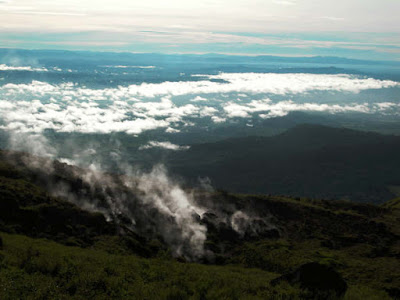Among the most powerful images that come to mind when one thinks of Nicaragua are those of
. Both foreign travelers and Nicaraguans are stunned by the views. The lake occupies a deep, wide volcanic crater, with relatively steep interior sides, making the lake essentially occupy a hole in the ground. Its clear water is warm, inviting and clean.
Although most references to Apoyo characterize it as a lake, it is a true volcano. The lake is often called a crater lake, in which its water has no open flows outward. In fact, its volcanic origins are demonstrated, as there are warm water vents in the lake at several points. Its shape is considerably different from other, more typical volcanoes, such as Masaya and Mombacho, between which Apoyo lies. There is no overground flow of water out of the lake, and its water is slightly salty.
Especially on the weekends, Nicaraguans from the neighboring towns love to visit
Laguna de Apoyo, where they can picnic and relax in a natural setting, and the few who can swim my get into the water. The entire shoreline is public, making access to the lake wide, although many property owners along the shoreline may not cooperate with access to the water easily.
 |
| Photo Jeffrey McCrary. |
There really is nothing better than being on the
lake, in the water. But that is not the only way to enjoy the lake. The view from
Catarina, for instance, is spectacular, and one is often serenaded by folk musicians. There, one can enjoy an ice cream or even a full dinner while marveling at the constantly changing hues in patchwork style across the
water, with Volcano Mombacho to the right, Granada and Lake Nicaragua beyond, and
Volcano Masaya to the left.
 |
| Photo Belen Camino. |
The lake can produce whitecaps during the dry season, but when still, especially in the mornings of the rainy season (May through November), the
lake can reflect the profiles on the opposite side. Mombacho, often capped by lenticular clouds, faces the viewer when observing from behind Estacion Biologica.
 |
| Photo Anne Sutton. |
Tourism to
Laguna de Apoyo can be massive during certain periods, especially around Easter week. Other times, such as in October, can be relatively quiet. Not only the traffic varies with the season, but also the water and the surrounding forests. Winds are constant during the dry season, making the lake more choppy, whereas the surface may be smooth and reflective as a mirror during the rainy season.
 |
| Photo Regina Bernheim Delgadillo. |
Some of the beaches, such as in front of
Estacion Biologica, are made of black, volcanic sand. Others are rocky and steep. The lake varies from place to place. The water is warm (28 degrees C) year-round.
 |
Photo Lucy Lia Real.
|
 |
| The sirens of Ulysees may appear along the shore of Lake Apoyo. Photo Jen Moran. |
Although the black sand is characterized by eroded, volcanic obsidian, but other rocks are prominent along the water's edge, particularly pumice which floats and accumulates along the water's edge. Beaches may also contain patches of clay in some locations, and large, composite boulders are found alongside obsidian.
 |
| Clouds tend to set in during the rainy season, from May through November. Photo Jeffrey McCrary. |
The water of Laguna de Apoyo is slightly salty with volcanic minerals. There are no currents and the waves are very small. The lakefront in most places has a steeply inclined shoreline, but in front of Estacion Biologica, the shoreline is gently sloped, providing a large area in which one can stand and relax, while swimming in deeper water is possible just a few meters further inward.
 |
| Photo Heyling Aviles. |
 |
| Photo Lucy Lia Real. |
Would you like to visit us for a
swim and lunch? Or stay a few days? Please
contact us to enjoy our wonderful Lake Apoyo.




















